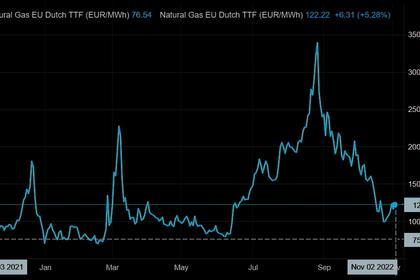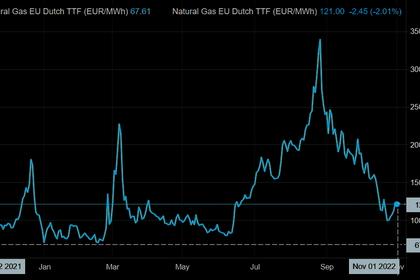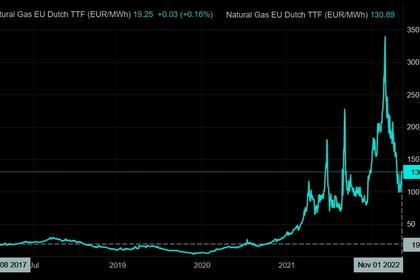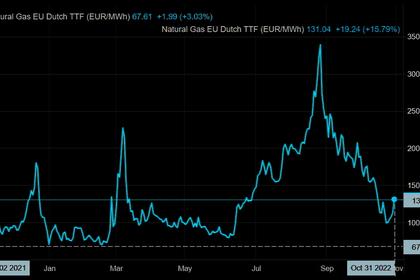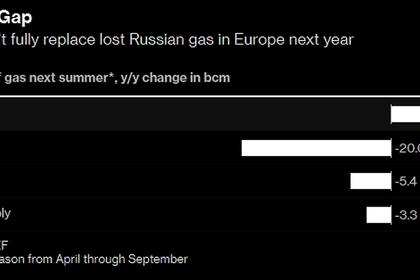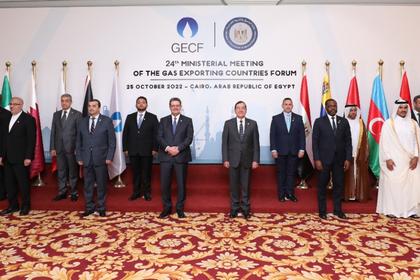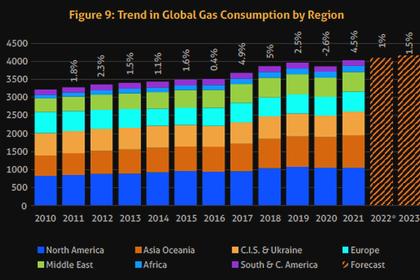
EUROPEAN ENERGY TRANSFORMATION
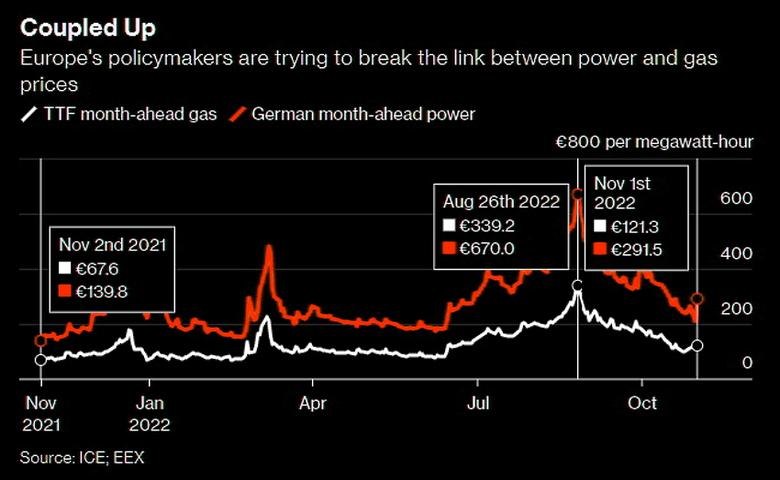
BLOOMBERG- Nov 3, 2022 - The European Union is hoarding natural gas to make it through the winter, but it’s also trying to solve a bigger problem: breaking the link between gas and power prices altogether.
Currently, the most expensive form of generation -- gas -- sets the price for all electricity that’s sold into the market. That means consumers are bearing the brunt of Russia’s supply cuts to the continent. It also means Europe isn’t feeling much of the benefit of low-cost renewables like wind farms, which get to sell at big margins.
Policymakers now have a once-in-a-generation opportunity to cut the tie to gas, allowing the region to become more reliant on cheaper, greener energy. The stakes are huge: getting it right could transform the market, while a misstep could worsen the supply crunch and scare off investment in renewables.
The bloc may have to introduce temporary fixes while a broad overhaul is under way. Here are some short- and long-term measures the EU is considering.
Gas Price Cap
As a stop-gap measure, EU officials have considered a broad cap on wholesale gas prices to bring down power costs, but the technical details are tricky. Any such step would need to avoid boosting demand, subsidizing electricity to foreign consumers or choking off imports. Critics have urged the EU to tread cautiously.
“Do not hamper the wholesale price signal,” said Steffen Koehler, chief operating officer of the European Energy Exchange. “It is essential for risk management. Let the wholesale market decide on a price first. And then if you really want to introduce a cap, do it as late in the process as possible.”
The European Commission has been considering a temporary, dynamic cap to curb price volatility to ease the energy crisis. EU member states aim to sign off on the commission’s short-term proposals at an emergency meeting on Nov. 24. It’s not clear if a wholesale gas-price cap will be included.
Iberian Model
A similar short-term fix would be to limit the price of gas used in electricity generation, which Spain and Portugal have already done. Gas-fired generators get to recover some of their lost revenue via a surcharge on consumer bills. The so-called “Iberian model” could lower wholesale prices across Europe by between 10% and 35%, according to Finnish energy technology company Wartsila Oyj.
As with a broader cap, lowering prices could discourage energy efficiency and increase power exports. Countries that use a lot of gas in power generation, like the Netherlands, may be on the hook for a higher share of costs. In addition, some generators could see huge profits if they’ve already sold forward their production and get reimbursed.
Revenue Limits
Non-gas generators can secure large profits by selling power that is based on expensive gas. A revenue cap -- a quick fix -- could limit this windfall, redirecting the excess to help offset household bills. The EU agreed to implement such a cap at €180 per megawatt-hour from December until June of next year.
“The biggest negative is that potential profits are taken away from efficient, clean, and cheap technologies, which is bad for longer-term investment,” said Fabian Ronningen, a power analyst at Rystad AS.
Another tricky aspect of this plan is dealing with hedging and forward markets. Generators sell much of their expected output months or years ahead, so there may be very little profit to capture if firms have already sold future output at lower prices.
Splitting the Market
In the longer-term, Europe could split the wholesale market in two, keeping the current marginal pricing system for fossil fuels and creating a separate market for renewables where prices would be defined at the time of auction.
The UK, while no longer part of the EU, has taken steps in this direction through the Contracts for Difference mechanism, which provides fixed revenues to clean generators. The CfDs prevent wind farms from reaping massive profits from the high prices set by gas, and any excess funds are sent back to suppliers to subsidize consumer bills.
The challenge with CfDs is setting the right revenue levels, which can be fixed for a decade or more. Recent discussions on expanding CfDs in the UK broke down quickly before a revenue cap was announced.
Locational Pricing
As conducted in different forms in the Nordics and the US, locally-priced electricity could be implemented in the longer term to reflect the cost of transmission bottlenecks, instead of one wholesale price across a country.
However, this could increase investment risk “as prices can swing with changes in the local supply-demand balance,” wrote Coralie Laurencin, senior director at S&P Global Commodity Insights. Still, it’s an option being discussed by Ofgem, the regulator in the UK, where tight grid capacity between Scotland and England means generators in the north often need to be paid to switch off, raising costs for consumers.
Pay-as-Bid
Day-ahead power market auctions are currently conducted “pay-as-cleared,” where everyone gets paid the price for which the most expensive producer offers to generate power. That could be changed to pay-as-bid, where prices would be closer to each generator’s respective cost of production. That means a wind farm would sell into the same market as a gas plant, only at a much lower rate.
“A weighted average price based on a pay-as-bid auction could more accurately reflect the electricity generation mix, potentially limiting the impact of gas on power prices in markets with high level of non-gas power generation,” Laurencin said. This market intervention, however, could increase speculative trading and lead to no or limited decline in power prices, she added.
Doing Nothing
Some analysts say a long-term power market redesign in the EU isn’t needed, leaving room for temporary interventions at most. The current scheduled acceleration of renewables means that cheaper energy sources will increasingly set power prices as more wind and solar is built, eventually phasing out gas.
“We see that the market works very well also toward 2050 and long term in the current market design,” said Sebastian Braun, head of power and hydrogen quant analytics at ICIS.
-----
Earlier:
